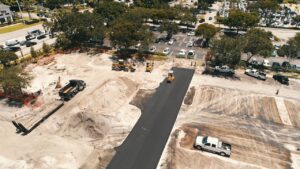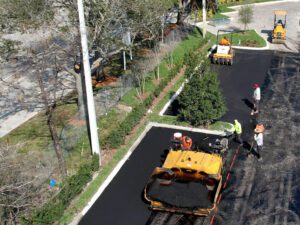 If you have ever watched an asphalt road construction crew at work, the process may have appeared as simple as dump, rake, and roll. In reality, what you were seeing was an intricate dance that involved meticulous timing, ground personnel, and heavy equipment operators to complete a process that began much earlier.
If you have ever watched an asphalt road construction crew at work, the process may have appeared as simple as dump, rake, and roll. In reality, what you were seeing was an intricate dance that involved meticulous timing, ground personnel, and heavy equipment operators to complete a process that began much earlier.
What Is the Starting Point for Asphalt Road Construction?
Whether they are planning a commercial or municipal asphalt paving project, contractors typically start by evaluating the topographical features at and around the proposed site. Are there steep-sided hills that could produce runoff that causes problems for the pavement? Can the road be installed so that the grade is not excessive? Are there boulders or outcroppings that will need to be removed or avoided? What kinds of trees or other vegetation will need to be cleared? At this point, the asphalt paving company will usually go ahead and evaluate the soil to determine its qualities. If the soil contains too much sand or clay, the contractor may need to amend it by removing and replacing some of it.
What Is the Second Phase of Asphalt Road Construction?
During the second phase, municipal and commercial asphalt paving contractors generally develop the engineering specifications for the pavement itself. Based on the estimated weights and numbers of vehicles that are expected to use the pavement on an average day, the asphalt paving company calculates how thick the pavement and its supporting base will need to be. This allows asphalt contractors to schedule the delivery of the asphalt at the correct intervals as well as schedule the appropriate equipment and crew members.
What Happens During the Third Phase of Asphalt Paving?
The third phase is the actual construction of the pavement and the base. Typically, the soil is compacted, and then the base is constructed and compacted. One layer at a time, the asphalt is placed, worked, and compacted until the total thickness of the pavement reaches what was specified in the engineering design.
Is the Process for Installing an Asphalt Overlay the Same as It Is for Constructing a New Road?
There are some similarities, but the complete process is not identical. A road or parking lot paving contractor will usually need to complete the steps listed above in the section on the second phase of road construction. However, an asphalt overlay installation also requires the contractor to correct any underlying issues that caused the damage to the existing pavement. Two to three inches of the existing asphalt will be ground away by a milling machine, and, if necessary, any damage exposed by the milling procedure will be corrected. The correct number of asphalt layers will be placed, worked, and compacted.
Trust 3-D Paving for Superior Service and Expert Workmanship
3-D Paving offers a complete range of paving services, including asphalt paving, concrete installation, asphalt repair, parking lot striping, thermoplastic markings, asphalt sealcoating, site development, reflective pavement markers, asphalt overlay installation, speed bumps, parking lot signage, and bollard installations. We serve clients from virtually all industries throughout South Florida. We have an exemplary reputation, impeccable references, and the ability to handle jobs of all sizes and types. We offer free quotes, so submit the online form to request yours. If you would rather, you can also call our office in Coral Springs at 855-735-7623.







